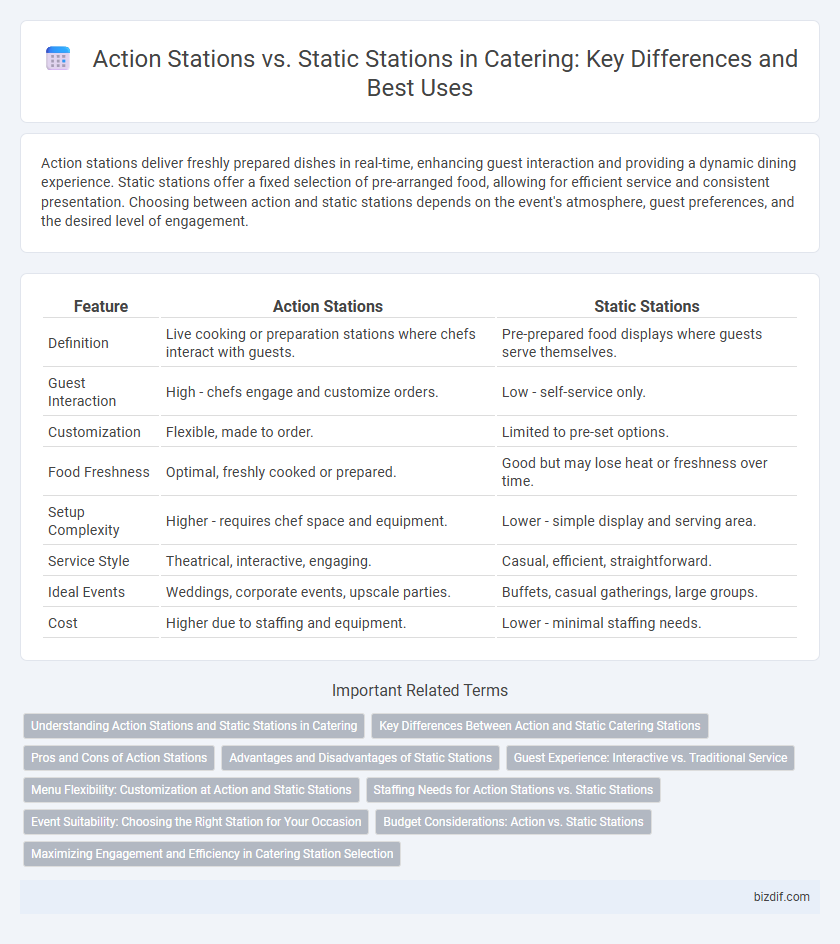Action stations deliver freshly prepared dishes in real-time, enhancing guest interaction and providing a dynamic dining experience. Static stations offer a fixed selection of pre-arranged food, allowing for efficient service and consistent presentation. Choosing between action and static stations depends on the event's atmosphere, guest preferences, and the desired level of engagement.
Table of Comparison
| Feature | Action Stations | Static Stations |
|---|---|---|
| Definition | Live cooking or preparation stations where chefs interact with guests. | Pre-prepared food displays where guests serve themselves. |
| Guest Interaction | High - chefs engage and customize orders. | Low - self-service only. |
| Customization | Flexible, made to order. | Limited to pre-set options. |
| Food Freshness | Optimal, freshly cooked or prepared. | Good but may lose heat or freshness over time. |
| Setup Complexity | Higher - requires chef space and equipment. | Lower - simple display and serving area. |
| Service Style | Theatrical, interactive, engaging. | Casual, efficient, straightforward. |
| Ideal Events | Weddings, corporate events, upscale parties. | Buffets, casual gatherings, large groups. |
| Cost | Higher due to staffing and equipment. | Lower - minimal staffing needs. |
Understanding Action Stations and Static Stations in Catering
Action stations in catering involve live cooking where chefs prepare food in front of guests, enhancing engagement and customization. Static stations offer pre-prepared dishes arranged at fixed locations, providing convenience and efficient service for large events. Understanding the balance between dynamic interaction at action stations and streamlined flow at static stations is essential for effective event catering.
Key Differences Between Action and Static Catering Stations
Action stations provide live cooking experiences where chefs prepare dishes on demand, offering customization and interactive engagement for guests. Static stations feature pre-prepared food items displayed in a fixed area, allowing for quick self-service but less flexibility in meal choices. The key difference lies in dynamic guest interaction and food freshness at action stations versus efficiency and ease of access at static stations.
Pros and Cons of Action Stations
Action stations offer interactive cooking experiences where chefs prepare food live, enhancing guest engagement and ensuring freshly made dishes with customizable options. However, they can involve higher staffing costs and longer wait times compared to static stations, which present pre-prepared food for quicker service. The dynamic nature of action stations creates a vibrant atmosphere but may pose logistical challenges in space and workflow management.
Advantages and Disadvantages of Static Stations
Static stations in catering offer the advantage of consistent presentation and streamlined service, ideal for controlled environments like corporate events or weddings. They simplify logistics by requiring less staff movement, ensuring food quality and temperature are maintained throughout the event. However, static stations may limit guest interaction and variety, potentially leading to slower service lines and reduced engagement compared to dynamic action stations.
Guest Experience: Interactive vs. Traditional Service
Action stations offer an interactive guest experience where chefs prepare dishes in real-time, enhancing engagement and customization. Static stations provide a traditional service style with pre-arranged, self-serve or buffet options, focusing on convenience and consistency. The choice between these stations directly influences guest satisfaction by balancing interaction with efficiency.
Menu Flexibility: Customization at Action and Static Stations
Action stations offer dynamic menu flexibility by allowing chefs to customize dishes on demand, tailoring ingredients and cooking techniques to individual guest preferences. Static stations provide a curated menu with limited customization, focusing on consistency and efficiency through pre-prepared selections. Both station types can be designed for specialized cuisine themes, but action stations excel in interactive customization and fresh preparation.
Staffing Needs for Action Stations vs. Static Stations
Action stations require a higher staffing level, typically involving skilled chefs to prepare food live, ensuring freshness and customization for guests. In contrast, static stations operate with minimal staff, as food is pre-prepared and displayed for self-service or minimal interaction. The staffing cost and complexity for action stations are significantly greater due to the need for continuous food preparation and guest engagement.
Event Suitability: Choosing the Right Station for Your Occasion
Action stations offer interactive food preparation, making them ideal for dynamic events like weddings or corporate mixers where guest engagement is a priority. Static stations provide a more traditional buffet setup, suited for formal occasions or large gatherings requiring efficient service and minimal movement. Selecting between action and static stations depends on event size, guest interaction preferences, and the desired ambiance.
Budget Considerations: Action vs. Static Stations
Action stations typically require higher budgets due to the need for skilled chefs, specialized equipment, and increased staffing levels, making them more costly than static stations. Static stations often offer a more cost-effective option by utilizing pre-prepared dishes and minimal staff presence, reducing overall labor and operational expenses. Budget constraints should carefully assess the trade-off between the interactive experience of action stations and the economical efficiency of static stations.
Maximizing Engagement and Efficiency in Catering Station Selection
Action stations promote engagement by allowing chefs to prepare dishes live, fostering interaction and customization, which enhances guest experience. Static stations streamline service with pre-prepared options, improving efficiency and reducing wait times during peak hours. Balancing action and static stations optimizes catering operations by combining dynamic guest interaction and swift service delivery.
Action stations vs Static stations Infographic

 bizdif.com
bizdif.com